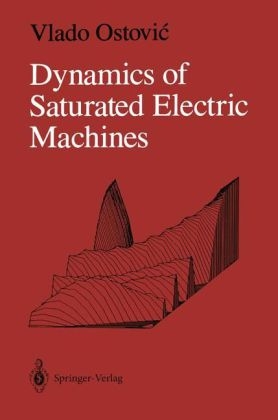
Dynamics of Saturated Electric Machines
Springer-Verlag New York Inc.
978-0-387-97079-0 (ISBN)
- Titel ist leider vergriffen;
keine Neuauflage - Artikel merken
1 Introduction.- 2 Magnetic Circuits.- 2.1 Analogies Between Electric and Magnetic Circuits.- 2.2 Permeances in Magnetic Circuits.- 2.2.1 Constant Permeances.- 2.2.2 Parametric Nonlinear Permeances.- 2.2.2.1 Unskewed Machine with Different Number of Stator and Rotor Slots.- 2.2.2.2 Influence of Skewing.- 2.2.2.3 Rotor Eccentricity.- 2.2.2.4 Complete Air Gap Permeance.- 2.2.2.5 Influence of Fringing Flux.- 2.2.3 Inherently Nonlinear Permeances.- 2.2.3.1 B-H Curve Approximation.- 2.2.3.2 Influence of Variable Geometry.- 2.2.4 Convention About Symbols.- 2.3 Sources in Magnetic Circuits.- 2.3.1 Magnetomotive Force of a Coil in a High-Permeability Medium.- 2.3.2 Magnetomotive Force of a Distributed Winding.- 2.3.3 Permanent Magnets in Magnetic Circuits.- 2.3.4 Convention About Symbols.- 2.4 Force and Torque.- 2.5 Magnetic Equivalent Circuits of Electromagnetic Devices.- 2.5.1 Singly and Multiply Excited Iron Core.- 2.5.2 Windings in Slots.- 2.5.3 Elementary Pole Pair.- 2.5.3.1 The Number of Stator Parallel Circuits Restriction.- 2.5.3.2 Stator Fractional Slot Winding Restriction.- 2.5.3.3 The Number of Rotor Slots per Pole Restriction.- 2.5.3.4 Summary of Conditions for the Number of Elementary Pole Pairs.- 2.5.3.5 The Number of Stator and Rotor Slots per Elementary Pole Pair.- 2.5.4 Induction Machine.- 2.5.5 Salient Pole, Wound Rotor Synchronous Machine.- 2.5.6 Permanent Magnet Synchronous Machine.- 2.5.7 Stepper and Switched Reluctance Motor.- 2.5.8 Shaded Pole Induction Machine.- 2.5.9 Conductive Plate in External Magnetic Field.- 2.6 Magnetic Equivalent Circuit Solution Procedure.- 2.6.1 Node Potential Equations and Permeance Matrices.- 2.6.2 k-Winding, n-Limb Transformer.- 2.6.3 Induction Machine.- 2.6.3.1 Simple Model.- 2.6.3.2 Complex Model.- 2.6.4 Wound Rotor Synchronous Machine.- 2.6.5 Permanent Magnet Synchronous Machine.- 2.6.6 Stepper and Switched Reluctance Motor.- 2.6.7 Shaded Pole Induction Machine.- 3 Winding Transform Matrices.- 3.1 Winding Topology Matrix.- 3.1.1 Single-Layer Windings.- 3.1.1.1 Concentric Winding.- 3.1.1.2 Distributed Winding.- 3.1.2 Double-Layer Winding.- 3.2 Number of Turns per Coil Matrix.- 3.3 Coil Currents Matrix.- 3.4 Slot Ampere-Turns Matrix.- 3.4.1 Single-Layer Winding.- 3.4.1.1 Concentric Winding.- 3.4.1.2 Distributed Winding.- 3.4.2 Double-Layer Winding.- 3.4.2.1 One-Layer Model.- 3.4.2.2 Two-Layer Model.- 3.5 Tooth Magnetomotive Force Matrix.- 3.6 Magnetomotive Force Transform Matrix w?.- 3.7 Coil Flux Matrix.- 3.7.1 Single-Layer Winding.- 3.7.1.1 Concentric Winding.- 3.7.1.2 Distributed Winding.- 3.7.2 Double-Layer Winding.- 3.7.2.1 One-Layer Model.- 3.7.2.2 Two Layer Model.- 3.8 Number of Turns per Elementary Phase Matrix.- 3.9 Elementary Phase Flux Matrix.- 3.9.1 Single-Layer Windings.- 3.9.1.1 Concentric Winding.- 3.9.1.2 Distributed Winding.- 3.9.2 Double-Layer Windings.- 3.10 Flux Transform Matrix w?.- 3.11 Summary of Winding Transform Matrices.- 3.12 Squirrel Cage Connection Matrices.- 4 Extended System of Machine Algebraic Equations.- 4.1 Squirrel Cage Induction Machine — A Simple Model.- 4.2 Squirrel Cage Induction Machine — A Complex Model.- 4.3 Wound Rotor Synchronous Machine.- 4.4 Permanent Magnet Synchronous Machine.- 4.5 Stepper and Switched Reluctance Motor.- 4.6 Shaded Pole Induction Motor.- 5 Machine System of Differential Equations and Complete System of Algebraic Equations.- 5.1 Stator Differential Equations of an A.C. Machine.- 5.1.1 Voltage-Fed m-Phase Machine.- 5.1.1.1 Polygon Connection.- 5.1.1.2 Star without Common Neutral Connection.- 5.1.1.3 Star with Common Neutral Connection.- 5.1.2 Current-Fed m-Phase Machine.- 5.1.2.1 Polygon Connection.- 5.1.2.2 Star without Common Neutral Connection.- 5.1.2.3 Star with Common Neutral Connection.- 5.1.3 Summary of Stator Winding Connection Types.- 5.1.4 Voltage Equations of Other Types of A.C. Machines.- 5.1.5 Failures in a Voltage-Fed A.C. Machine Stator Winding.- 5.1.5.1 Voltage-Fed m-Phase Machine; Polygon Connection.- 5.1.5.2 Voltage-Fed m-Phase Machine; Star without Common Neutral Connection.- 5.1.5.3 Voltage-Fed m-Phase Machine; Star with Common Neutral Connection.- 5.1.6 Failures in a Current-Fed A.C. Machine Stator Winding.- 5.1.6.1 Current-Fed m-Phase Machine; Polygon Connection.- 5.1.6.2 Current-Fed m-Phase Machine; Star without Common Neutral Connection.- 5.1.6.3 Current-Fed m-Phase Machine; Star with Common Neutral Connection.- 5.2 Rotor Differential Equations of an A.C. Machine.- 5.2.1 Squirrel Cage Winding Voltage Differential Equations.- 5.2.2 Wound Rotor Voltage Differential Equations.- 6 Unique System of Machine Equations.- 6.1 Influence of Series-Added Impedance.- 6.1.1 Inductors in Series with a Machine.- 6.1.2 Capacitors in Series with a Machine.- 6.2 k-Winding, n-Limb Transformer.- 6.3 Induction Machine — a Simple Model.- 6.3.1 Voltage-Fed Machine.- 6.3.2 Current-Fed Machine.- 6.4 Squirrel Cage Induction Machine — a Complex Model.- 6.4.1 Voltage-Fed Machine.- 6.4.2 Current-Fed Machine.- 6.5 Wound Rotor Synchronous Machine.- 6.6 Permanent Magnet Synchronous Machine.- 6.7 Step and Switched Reluctance Motor.- 6.8 Shaded Pole Induction Machine.- 6.9 Initial Conditions Definition.- Appendix I - Matrix Operators.- Appendix II - Vector and Matrix Differentiation.- Appendix III - Applications.- III.1. Squirrel Cage Induction Machine.- III.1.1 Starting Characteristics of the Basic Machine.- III.1.2 Basic Machine with Additional Inertia on the Shaft.- III.1.3 Basic Machine with a Decreased Number of Rotor Slots and an Additional Inertia on the Shaft.- III.1.4 Basic Machine with Linear B-H Curve and Additional Inertia.- III.1.5 Wye-Connected Basic Machine with Additional Inertia.- III.1.6 Reversing of the Basic Machine with Additional Inertia.- III.1.7 Basic Machine with Blocked Rotor.- III. 1.8 Basic Machine with Full Pitch Stator Winding and Additional Inertia.- III.1.9 Wye-Connected Basic Machine with 4/6 Winding Pitch.- III.1.10 Basic Machine with Unskewed Rotor and Additional Inertia.- III.1.11 Unsymmetric Connection of the Basic Machine.- III.1.12 Basic Machine in Steinmetz Connection.- III.1.13 Basic Machine with Additional Inertia Fed from a Six-Step Voltage Source Inverter.- III.1.14 Wye-Connected Basic Machine with Additional Inertia Fed from a Six-Step Voltage Source Inverter.- III.1.15 Basic Machine with Additional Inertia Fed from a Current Source.- III.1.16 Capacitor Braking of the Basic Machine.- III.1.17 D.C. Current Braking of the Basic Machine.- III.2. Permanent Magnet Synchronous Machine.- III.2.1 Starting of the Basic Machine without Permanent Magnets.- III.2.2 Starting of the Basic Machine.- III.2.3 Loading of the Basic Machine.- III.2.4 Heavy Loading — Loss of Synchronism.
| Zusatzinfo | Bibliography |
|---|---|
| Verlagsort | New York, NY |
| Sprache | englisch |
| Gewicht | 825 g |
| Themenwelt | Informatik ► Theorie / Studium ► Künstliche Intelligenz / Robotik |
| Technik ► Elektrotechnik / Energietechnik | |
| Technik ► Maschinenbau | |
| ISBN-10 | 0-387-97079-7 / 0387970797 |
| ISBN-13 | 978-0-387-97079-0 / 9780387970790 |
| Zustand | Neuware |
| Haben Sie eine Frage zum Produkt? |
aus dem Bereich


